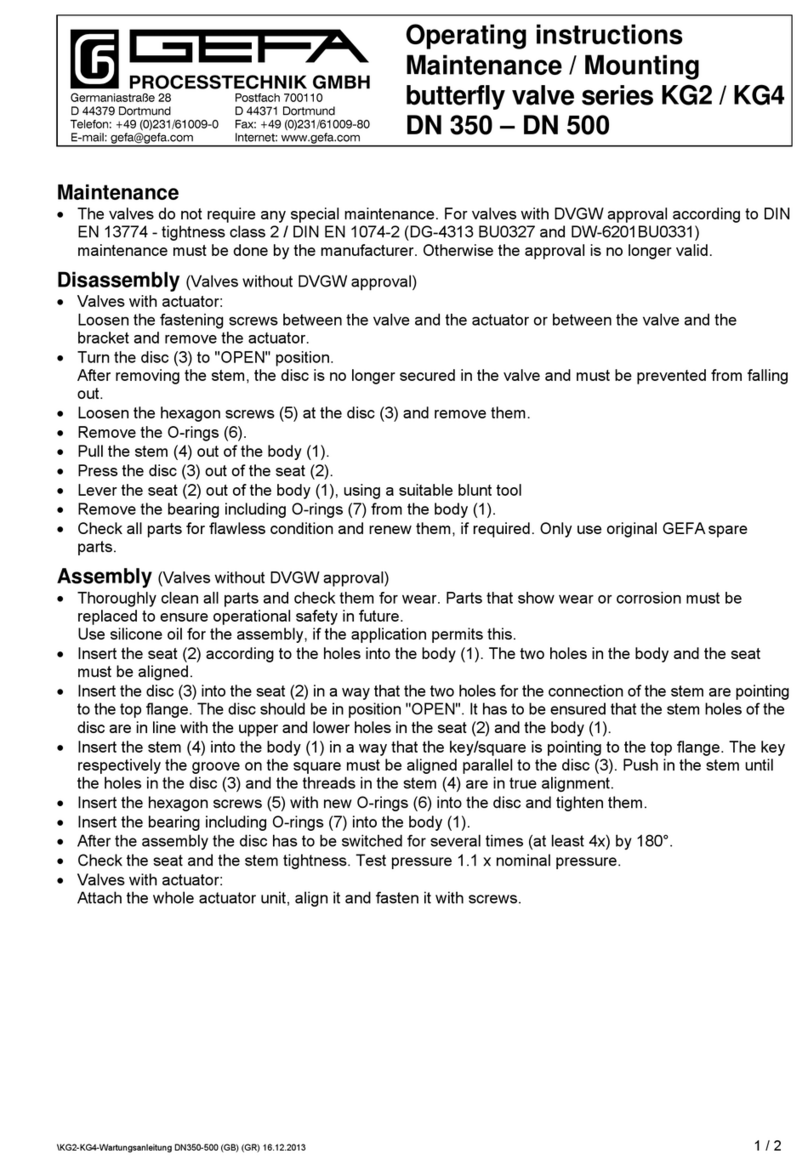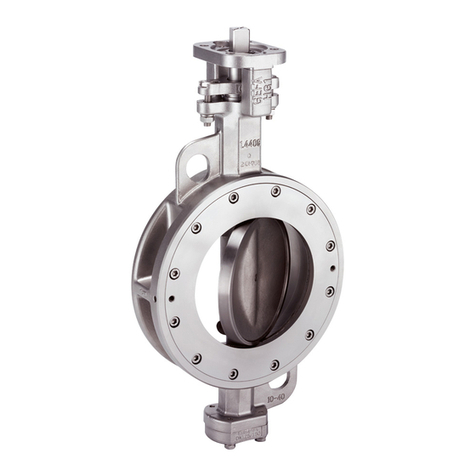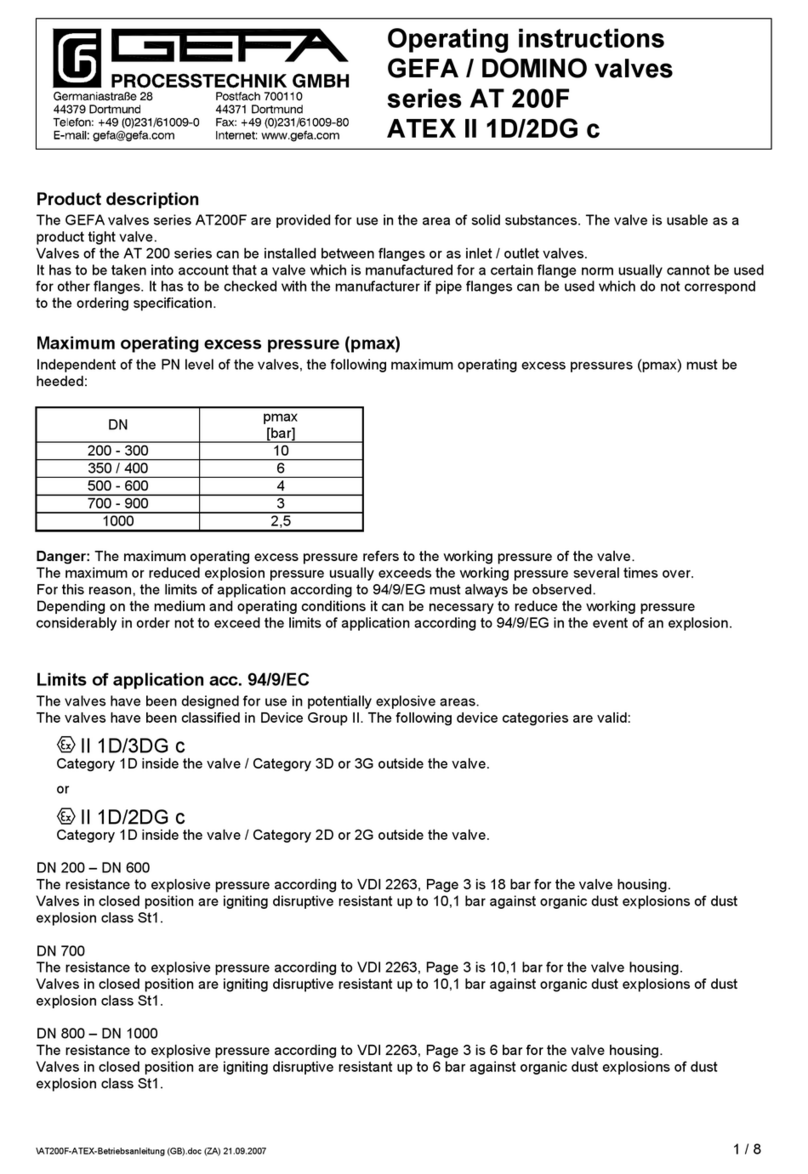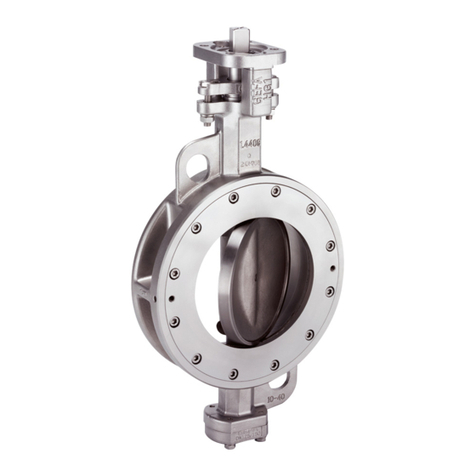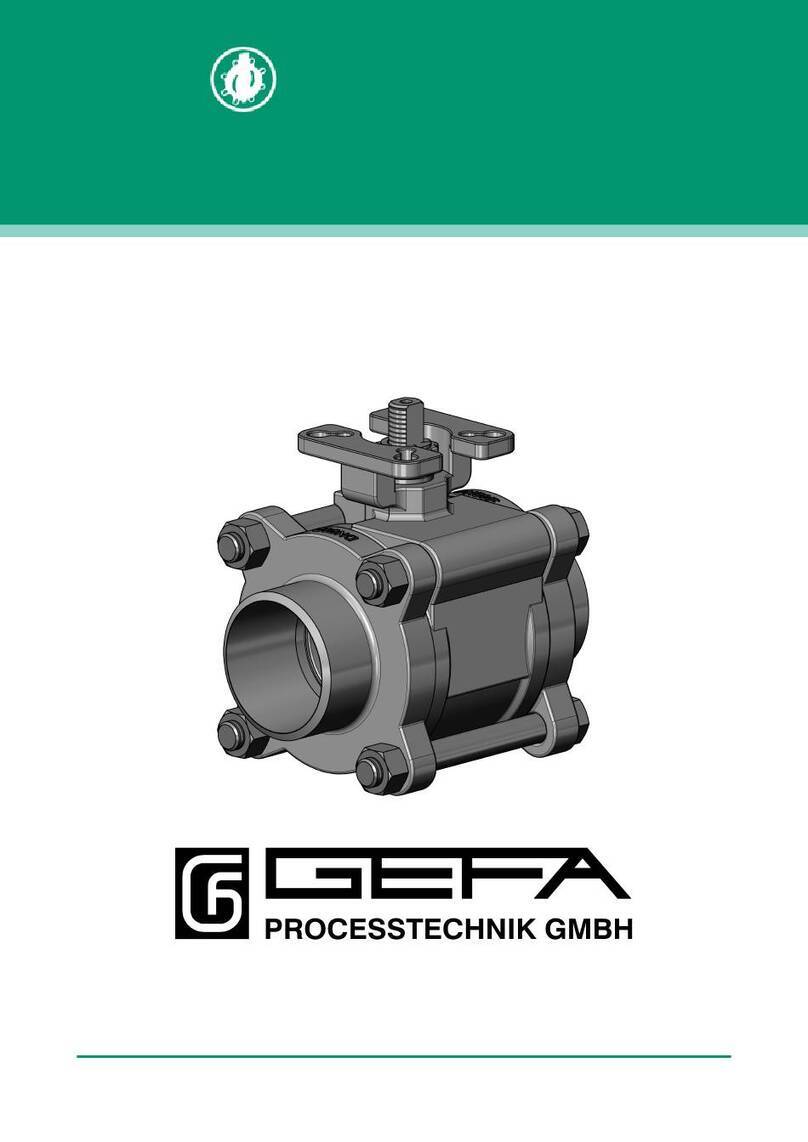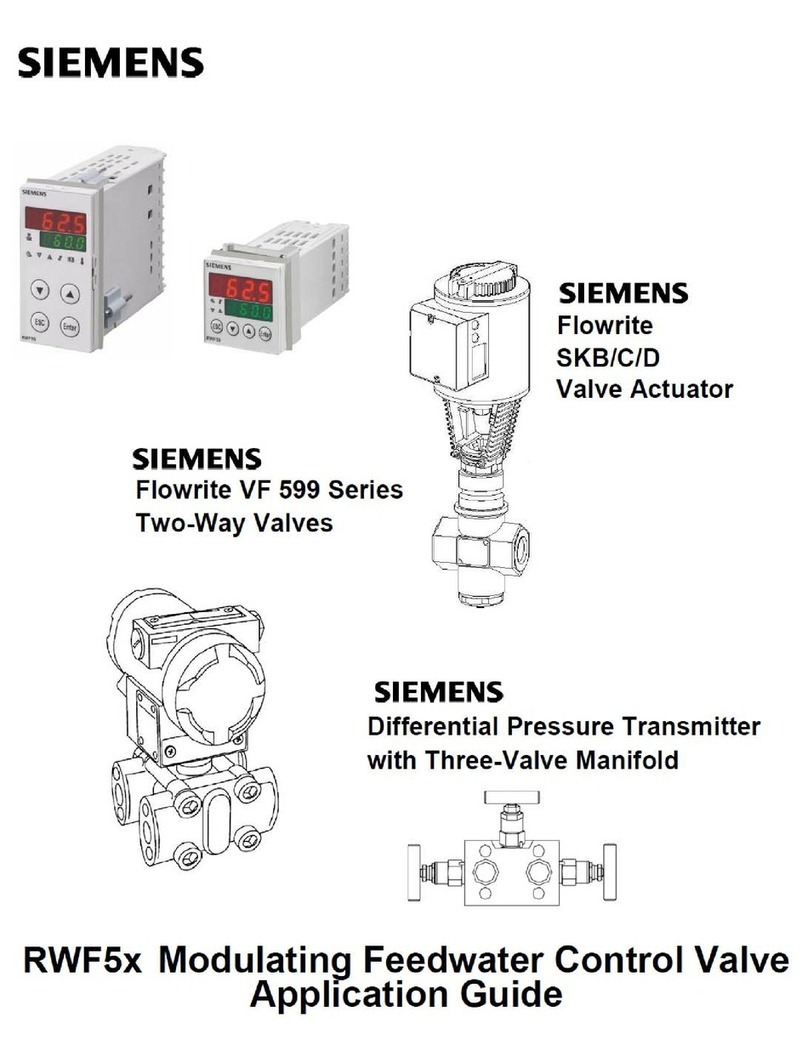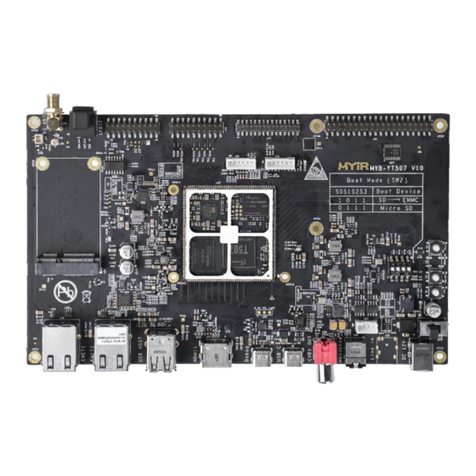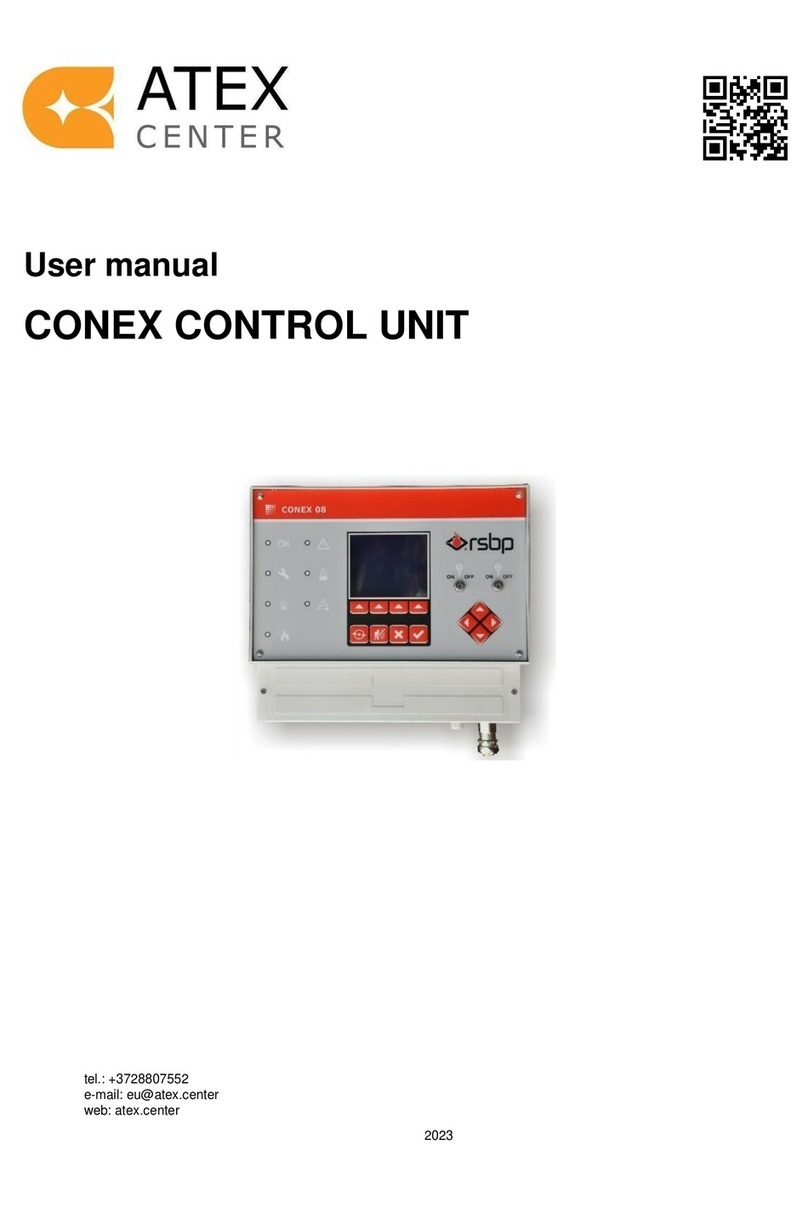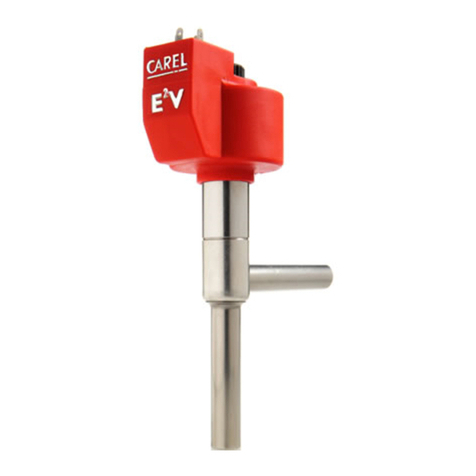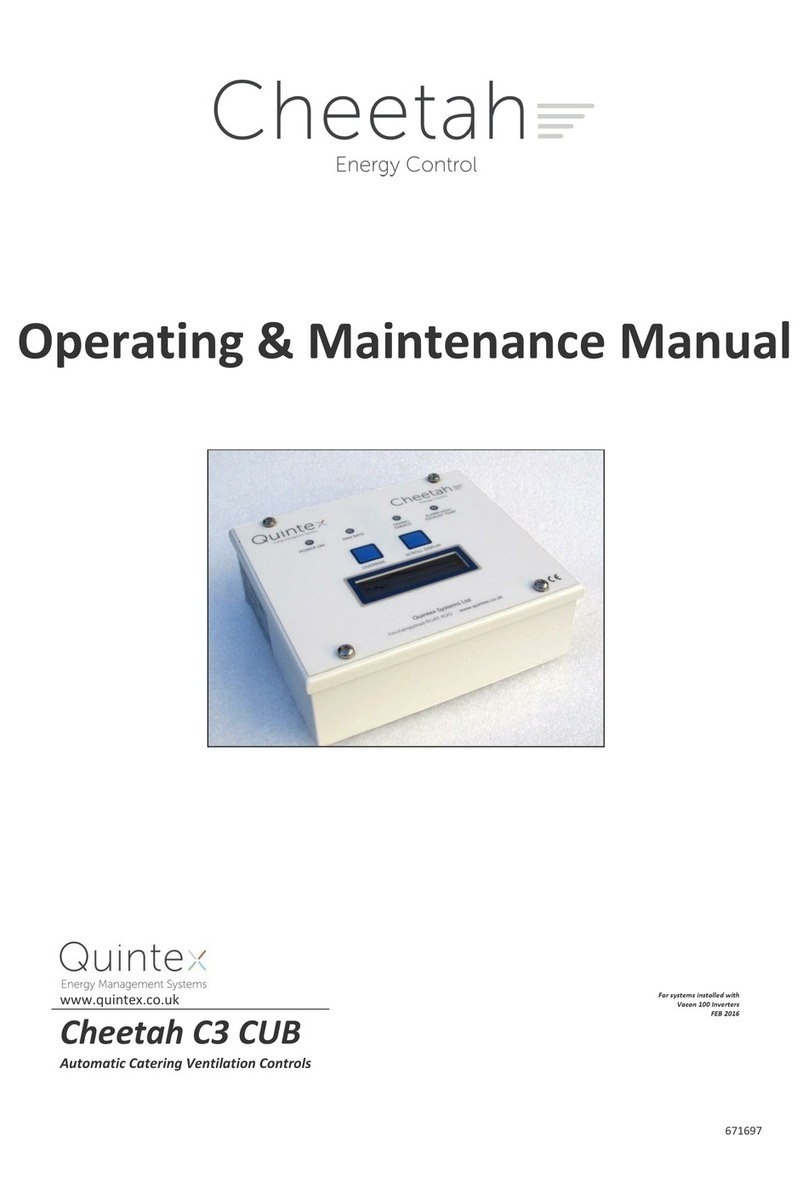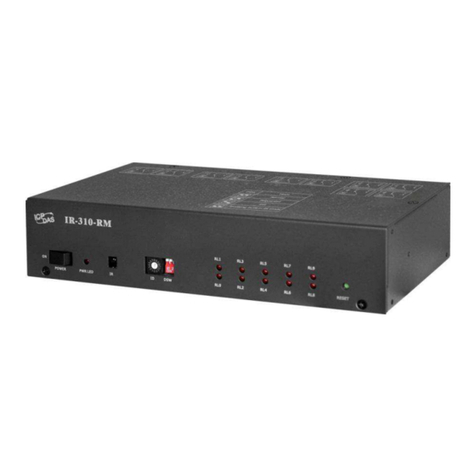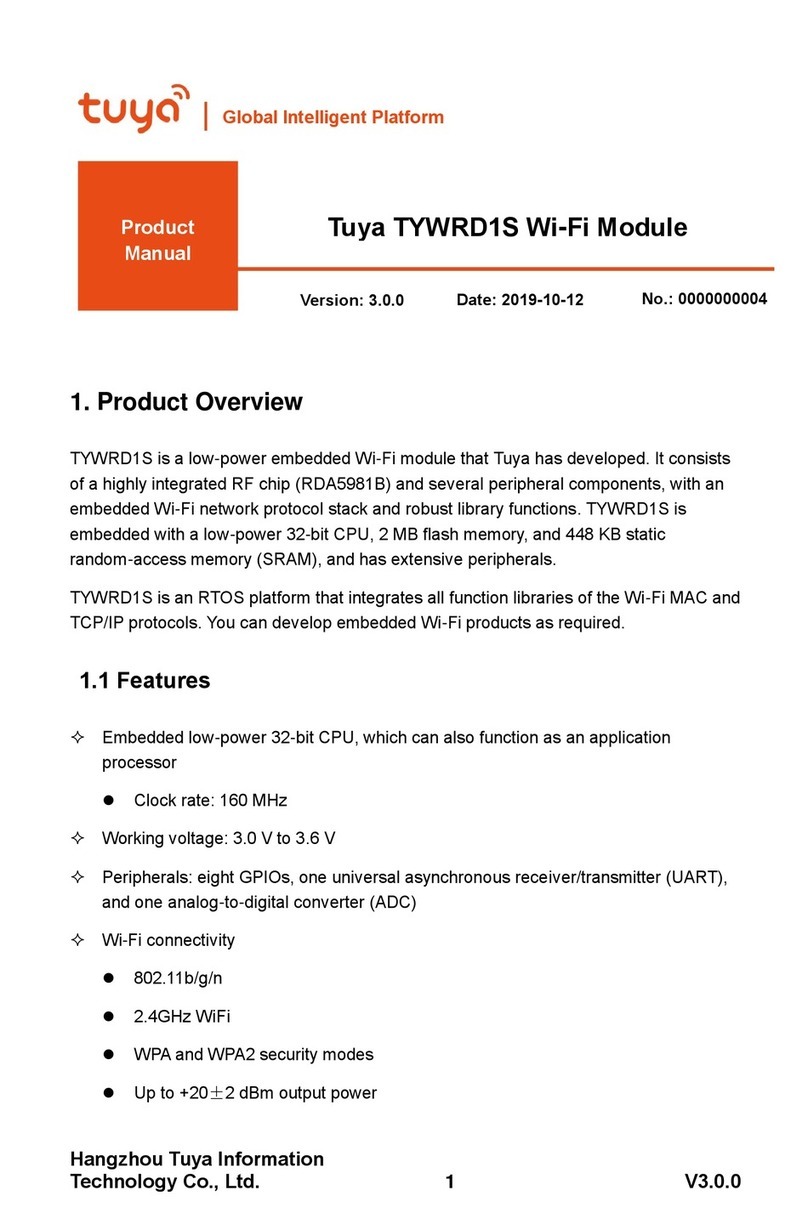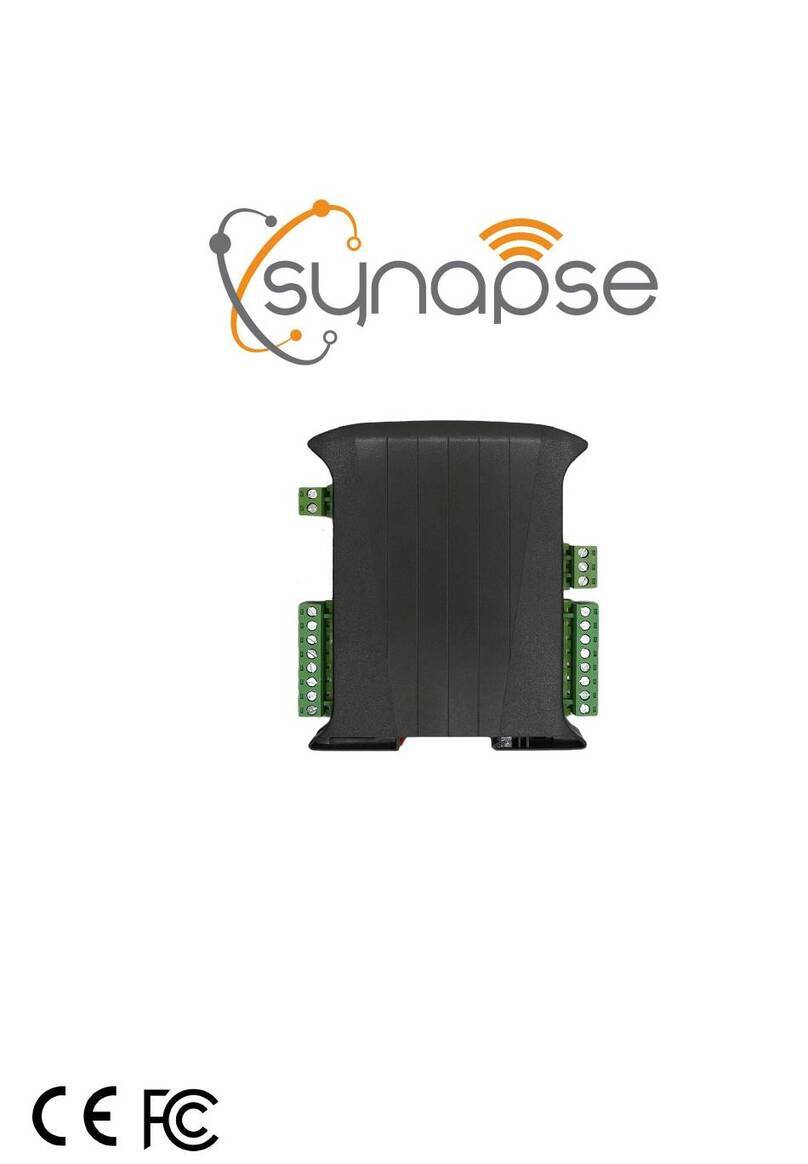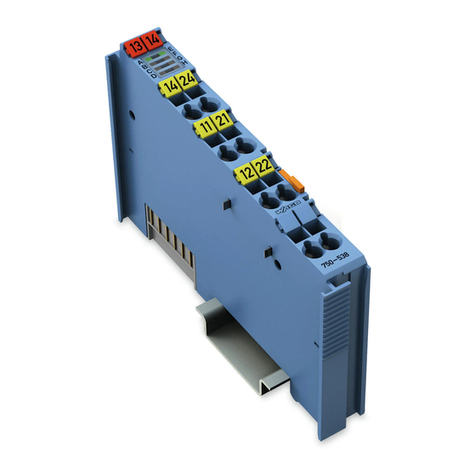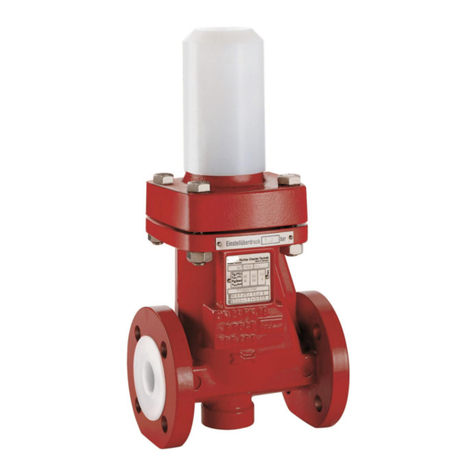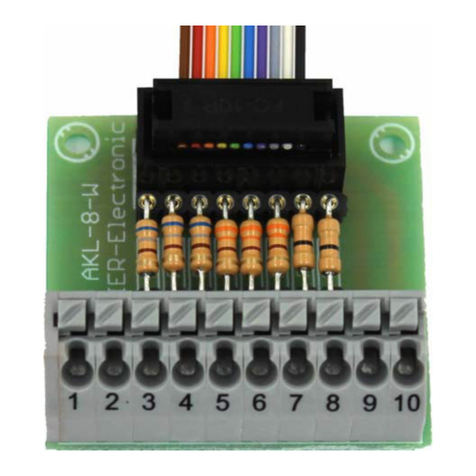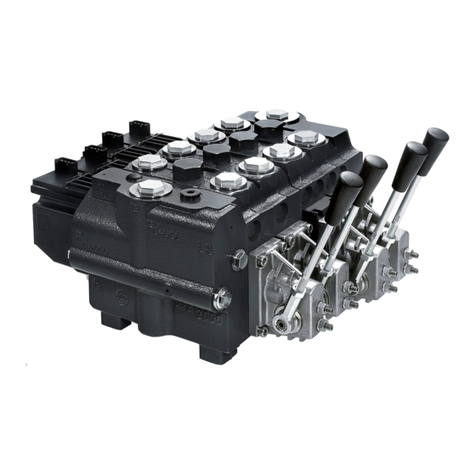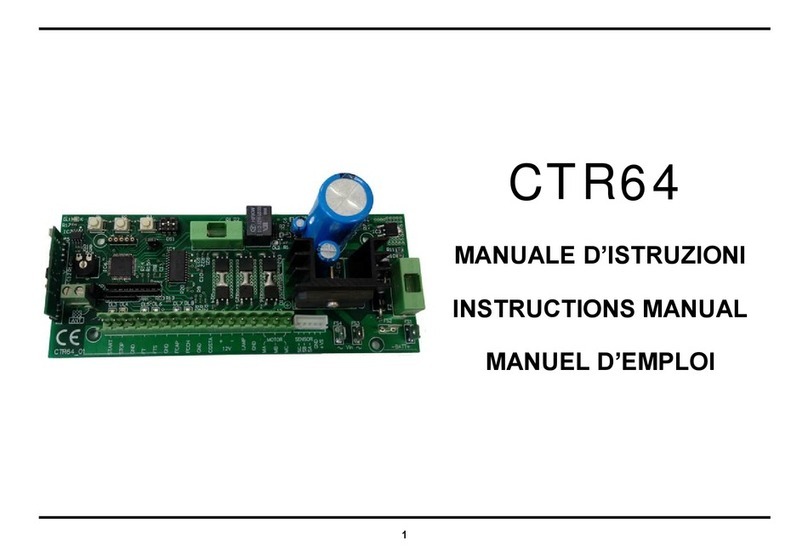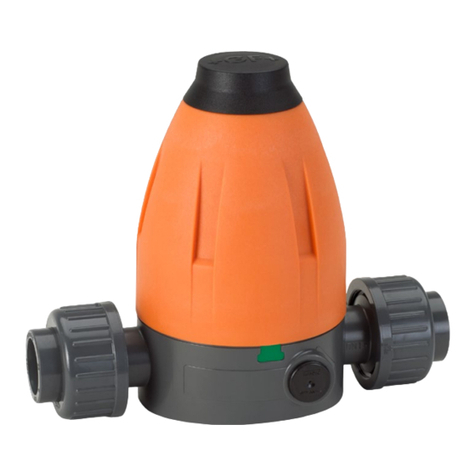Gefa Domino AT 100 Series User manual

\AT-Betriebsanleitung (GB) (GR) 16.06.2011 1 / 6
Instructions for use
DOMINO valves
AT 100 / 150 / 200 / 300 / 400 / 600
Instructions for use
Transport, storage, recommendations for installation and instructions for initial operation of
DOMINO valves
Valves with compact transverse seal
Series AT 100 / 150 / 200 / 300 / 400 / 600
1. Transport
2. Storage
3. Installation
3.1 Safety recommendations
3.2 Removal of additional corrosion preventative
3.3 Preservation of EKB (epoxy powder coating) and special painting
3.4 Protection of the valve
3.5 Place of installation
3.6 Position of installation
3.7 Direction of flow
4. Mounting
5. Initial operation
5.1 General measures
5.2 Shutting off powdery or granular media
5.3 Control pressure / use of control media
5.4 Pneumatically-operated valves
5.5 Hydraulically-operated valves
5.6 Electrically-operated valves
5.7 Bitumen valves
6. Recommendations for the maintenance of DOMINO valves
6.1 Readjusting the seal
6.2 Minor leaks
6.3 Lubrication of valves
6.4 Cleaning
7. Final remarks

Instructions for use DOMINO valves
AT 100 / 150 / 200 / 300 / 400/ 600
AT-Betriebsanleitung (GB) (GR) 16.06.2011 2 / 6
Transport, storage, recommendations for installation and instructions for initial operation of
DOMINO valves
1. Transport
1.1 The transportation of the valves to their final destination (building site) must be done in a solid box adapted
to the size of the valve taking into account the type of transport as well as any applicable regulations.
1.2 The valves must be suitably protected against external damage and atmospheric effects.
1.3 Depending on the duration of transportation and storage and also with regard to the climatic conditions,
preservation must be made by means of gas treatment or by shrink-wrapping and sealing the valve in
polyethylene film that also has an adequate amount of a desiccant such as silica gel placed inside.
2. Storage
2.1 The valves should be stored indoors in a dry place until final installation. All working parts must be suitably
covered to protect them against humidity, dust or other soiling.
2.2 During a longer period of storage or in the case of unfavourable storage conditions that might affect
subsequent functioning, all metallic bright surfaces such as the spindle, piston rod, and sealing surfaces
must be effectively protected against corrosion by means of a suitable and durable corrosion preventative.
2.3 The corrosion preventative applied at the factory must be checked for any damage in transit and suitably
repaired if needed.
2.4 For parts mounted on the valves, such as electrical actuators, limit switches, valves, etc., the corresponding
storage instructions of the relevant manufacturers shall have priority.
3. Installation
3.1 Safety recommendations
Operation of electrically, pneumatically, or hydraulically-operated valves that have not yet been
installed is not permitted. Warning: danger of accidents!
Protective device
Removal of the protective cover, except for installation, maintenance and / or repair work, is not
permitted. After dismantling the protective cover to carry out installation, maintenance and / or repair
work, attention should be paid to the movable parts of the valve.
Maintenance and repair work
Before starting maintenance or repair work, the pneumatic or hydraulic cylinders and the piping
system must be checked for residual energy (e.g. pressure buffer).
Automatic or remotely-operated valves must be disconnected from the automatic operation system
or remote control system for the duration of the maintenance or repair work.
Pneumatic cylinders equipped with an opening or closing spring may only be disassembled at the
factory of the manufacturer.
End valves
The user has the responsibility for taking care that all risks of accident are avoided by taking suitable
precautions in the danger zone for valves used as inlet valves. (The legal stipulations are to be
followed here.)

Instructions for use DOMINO valves
AT 100 / 150 / 200 / 300 / 400/ 600
AT-Betriebsanleitung (GB) (GR) 16.06.2011 3 / 6
3.2 Removal of additional corrosion preventative
Before the final installation of the valves, any corrosion preventative that has been applied as per section 2.2
above must be thoroughly removed. All parts, and in particular the valve plate, spindle and piston rod, must
be free of dust and dirt and, if necessary, well lubricated with a suitable lubricant before being used for the
first time.
Recommended lubricants:
Shell Alvania R2, Molikote-Longtherm 2 Plus or equivalent.
3.3 Preservation of EKB (epoxy powder coating) and special painting
Damage to the protected surfaces arising during installation or transport must be repaired by an expert.
Damage of this type is not covered by the warranty.
3.4 Protection of the Valve
If there is construction work still going on near or above the valves, they must be covered to protect them
against this construction work.
When painting the installation, the spindle, electrical components and the plate projecting from the housing
when the valve is open must not be painted. Any solvents used to remove unwanted paint must not come
into contact with the seals under any circumstances. This applies especially to the area where the valve plate
projects from the housing. If the installation is to be first cleaned by sand-blasting, the valves must be
covered with special care.
Debris from sand-blasting, and especially sand-blasting grit, which gets into those parts of the installation
that will be in contact with the valve during subsequent operation of the installation, must be removed
carefully. Sand-blasting grit can destroy the valve plates and seals within a very short time.
3.5 Place of installation
The possible locations for installing the valve must be selected such that surfaces A and B are freely
accessible for both sides to allow the seals to be readjusted if necessary.
Ensure that there is the necessary amount of space available for the packing tool C.
3.6 Position of installation
The position of installation of the respective valve must be chosen so that operation will be affected as little
as possible by the medium.
Valves should normally be installed upright in horizontal pipelines, i.e., actuator on top, and horizontally in
vertical pipelines. In the case of technically difficult installation conditions or in the case of custom-made
valves, please contact the manufacturer if there is any doubt regarding the exact position of installation.
3.7 Direction of flow
The direction of flow must be according to the direction of the arrow in custom-made valves.
4. Mounting
4.1 Avoid under all circumstances any tension or stresses in the valve housing caused by piping that has not
been aligned correctly or from piping that is under thermal stress.
4.2 Final remarks
Valves must always be installed near to supports in order to avoid stresses and tensions caused by bending
elements.
4.3 Valves of the AT 200 series can be installed between flanges or as inlet / outlet valves. If valves of the
AT 100 / AT 150 series are to be used as inlet / outlet valves, we recommend the use of an additional
counterflange (e.g. as per DIN 2642).

Instructions for use DOMINO valves
AT 100 / 150 / 200 / 300 / 400/ 600
AT-Betriebsanleitung (GB) (GR) 16.06.2011 4 / 6
5. Initial Operation
5.1 General measures
Before finally putting the valves into service, all the important elements (plate, spindle, piston rod, etc.) must
be cleaned thoroughly. Any damage to the plate, especially to the seal as a result of sand-blasting debris or
welding beads, external rust, etc., is not covered by the warranty.
Cleaning agents that include solvents especially those based on aromatic hydrocarbons (thinners, petroleum
spirit and the like) must not be allowed to get into contact with the seal.
5.2 Shutting off powdery or granular media
When shutting off powdery or granular media, ensure that any wetness or humidity caused by the installation
work and which might cause a subsequent caking of the medium must be thoroughly removed before the
installation is started up when using the medium. Malfunctions of the valve caused by agglutination or caking
of powdery media are not covered by the warranty.
5.3 Control pressure / use of control media
Check the input of the control pressure as the maximum permissible upper limit before applying pressure to
hydraulic and pneumatic cylinders. The maximum permissible control pressure will be stated in the order
confirmation. No other medium may be used other than the specified.
5.4 Pneumatically-operated valves
Before initial operation, all the air lines provided by the customer as well as the pneumatic control valves
must be thoroughly blown and also cleaned if necessary.
We recommend the use of lightly oiled compressed air to actuate the cylinder. We recommend the following
oils for the maintenance units: Shell Tellus Oil C 10, Wintershall Wiolan HN 46 or equivalent.
In operation, 1-2 drops per 1000 litres of air will be sufficient. Unless explicitly stated otherwise when
ordering, pneumatic control valves installed by us are supplied without accessories such as chokes or
silencers. The stipulations at the customer’s site must be followed.
Pneumatically-operated valves should not be closed suddenly, as otherwise there is a risk of pressure shock
(i.e. water-hammer).
5.5 Hydraulically-operated valves
Before initial operation, all the control lines provided by the customer must be thoroughly cleaned. We
recommend the use of the following oils to actuate the cylinder: Wintershall Wiolan HN 46 or equivalent.
Hydraulically-operated valves should not be closed suddenly, as otherwise there is a risk of pressure shocks
( i.e. water-hammer). Choker valves set at the factory must not be altered.
5.6 Electrically-operated valves of series AT 100 / 150 / 200 / 300 / 400 / 600
Closing may be done exclusively according to our instructions, as follows:
- only switch off in the closing direction by using a torque switch
- only switch off in the opening direction by using the path switch, the torque switch that is there serves as
overload protection and must also be closed
- in the case of custom-made valves such as of series AT 700 / 750, switching-off is done according
to our separate instructions
In the case of freely programmable controllers, the path switch and torque switch must be connected immediately
before the contactor coils. For functional reasons, only self-locking actuators may be used.
Signal transfer at the path switch and torque switch to switch off the electrical actuator must be done in real time.
Signal chaining via multiple contactors or positioning units causes the drive units to run on and can lead to the
destruction of certain components.
To avoid any risk of damage to the valve before it is operated electrically for the first time, move the plate by hand
to the middle position and only then operate the valve by means of the actuator.

Instructions for use DOMINO valves
AT 100 / 150 / 200 / 300 / 400/ 600
AT-Betriebsanleitung (GB) (GR) 16.06.2011 5 / 6
Check the phase sequence when connecting the power supply. The path switch and torque switch cannot operate
if the phase sequence is wrong.
The electrical actuator may not be operated unless the torque and limit switch function correctly. The torque set at
the factory must not be changed. If it is necessary to do this in exceptional cases, only do so after consulting the
manufacturer.
The heating and thermo-switches must be connected without fail to avoid a buildup of condensation and
overheating of the motor. Follow the special operating instructions of the relevant actuator manufacturer.
5.7 Bitumen valves
The valves were tested under pressure at the factory using water at the test bench at normal room
temperature. Before initial operation and in the heating-up phase at the bitumen-processing unit, the seals of
all valves should be readjusted as per sections 6.1 and 6.2 below.
If, however, any leakages are found after filling the unit with bitumen, then the readjusting as per sections 6.1
and 6.2 below should be repeated. Bitumen leakages and cooled remnants must be removed carefully to
prevent the seal from being destroyed in subsequent operation.
6. Recommendations for the maintenance of DOMINO valves
6.1 Readjusting the seal
During prolonged storage and in the event of larger temperature fluctuations, the sealing material of the seal
of the narrow face may shrink or else release air trapped in the seal and thus can cause minor leakages on
the narrow face of the plate.
If any leakage is found in the transverse seal in initial operation during the pressure test or after readjusting
the seal (as per the instructions for installation of the block profile transverse seal) or after a prolonged period
of disuse, and this still persists even after operating the valve several times, then the seal can easily be re-
tensioned while the valve is still installed. The valve should not, however, be under full operating pressure
when this work is done.
6.2 Minor leaks
Minor leaks can be eliminated by tightening
the packing hole screws (A). If this does
produce any significant improvement,
remove the packing hole screws (A) and
apply the packing material (B) by means of
the packing tool (C) until the valve is tight. In
the case of valves sealed with a transverse
seal, take care that the packing tool is
pushed into the hole provided in the seal
and the packing material is compressed
between the seals.
The packing hole screws (A) should be
tightened up again by about 3 turns.

Instructions for use DOMINO valves
AT 100 / 150 / 200 / 300 / 400/ 600
AT-Betriebsanleitung (GB) (GR) 16.06.2011 6 / 6
6.3 Lubrication of valves
Valves with hand-wheel operation
The spindle must always be kept well greased and free of dirt. The greasing points on the hand wheel
bearing must be regreased regularly depending on the conditions of operation and use.
Valves with pneumatic or hydraulic operation
The piston rod should be clean and free of dirt. A self-lubricating rod seal is used as standard with pneumatic
cylinders with damping. All the seals should be replaced if these cylinders leak.
Electrically-operated valves
The spindle must always be kept well greased and free of dirt. The greasing points on the actuator must be
checked. The respective instructions for use of the actuator manufacturer are binding.
Recommended lubricants:
Shell Alvania R2, Molikote-Longtherm 2 Plus or equivalent.
6.4 Cleaning
If specified by the customer, the valves can be provided with flushing or blowing facilities in the upper part of
the housing. Depending on the medium to be shut off and with regard to the process in question, the valve
should be flushed or blown during opening and closing.
Depending on the application, the valve plate and plate guides must also be cleaned.
If the valve is seldom operated, and especially in the case of automatic valves, a test run should be made at
least every 3 months to ensure permanent readiness for use and to avoid deposits from becoming baked on.
7. Final remarks
The details given here correspond to the latest state of our knowledge and, in connection with the technical
documentation, the purpose of providing information about our products and their range of applications.
They are not meant to guarantee particular features of the products or their suitability for specific
applications.
Any existing copyrights and patent rights must be taken into consideration. We guarantee the quality within
the scope of our terms and conditions of sale.
We reserve the right to make changes and improvements.

\AT-Einbauanleitung Dichtungen (GB).doc (BL) 31.03.2005 1 / 4
Operating Instructions
Maintenance / Sealing replacement
DOMINO knife gate valves series AT
1. General information
1.1 Maintenance work may only be carried out by qualified and authorised people.
1.2 Routine valve maintenance is not necessary. However, the spindle (piston rod in the case of
pneumatic or hydraulic cylinders) must always be well greased and free of soiling.
1.3 In the event of a minor leak where the plate passes through, this can usually be eliminated by
resealing (see "General Operating Instructions"). If the leak cannot be stopped in this way,
complete sealing replacement must take place. We recommend having the manufacturer carry
out the sealing replacement.
1.4 The following special tools are required for sealing replacement:
o Packing tool
o Suitable cutting tools (scissors, sanding disc)
o Suitable retaining fixtures (e.g. metal clamps) as a mounting aid
for cross-sealing and scraper
2. Spare parts
2.1 Only original spare parts may be used.
2.2 For complete sealing replacement, the following
spare parts are required:
o Cross-sealing
(compact cross-sealing,
cross-sealing with scraper or
U-profile (PTFE) with
silicone base)
o Suitable grease (e.g. Red Rubber)
o Round seal
o Ductile seal rhombic
o Ductile seal round (∅4mm)
3. Dismantling and cleaning
For complete sealing replacement, the valve must be removed from the pipeline.
o Check that the pipeline has been depressurised and emptied.
o Loosen the connections (electrical and pneumatic).
o Remove operating element.
o Loosen and remove the flange screws.
o Spread the flanges using a suitable tool and remove the valve and the seals.
o Loosen the screw fastening on the two halves of the housing and set the housing parts
down on the side with the flange sealing surface.
o Remove the old sealing material and clean the sealing areas thoroughly.

Maintenance / Sealing replacement
DOMINO knife gate valves series AT
AT-Einbauanleitung Dichtungen (GB).doc (BL) 31.03.2005 2 / 4
4. Preparing the front body part
4.1 Cut the cross-sealing (if appropriate scraper or base as
well) acsealing to the groove length.
Make the narrow ends of the sealing fit the shape of the
groove radii using a suitable tool (e.g. scissors or sanding
disc).
Lay the compact cross-
sealing in the cross-sealing
groove and grease it using a
suitable agent (e.g. Red
Rubber).
The narrower side must be
pointing towards the gate!
If a U-profile (PTFE)
with silicone base is
used, proceed as
shown below.
If a scraper is used in
combination with the
compact cross-sealing
proceed as shown on the
right.
4.2 Fix the sealing elements in place using a suitable retaining fixture (e.g. metal clamps).
5. Preparing the rear body part
5.1 Adapt and insert the cross-sealing (if appropriate scraper
or base as well) as described for the front body part.
5.2 Determine the length of the round seal by trial and error,
inserting it in the groove planned for it and cut it off
around 5-10 mm longer. (In its installed position, the sealing
should be slightly upset).

Maintenance / Sealing replacement
DOMINO knife gate valves series AT
AT-Einbauanleitung Dichtungen (GB).doc (BL) 31.03.2005 3 / 4
Insert the round seal in the bore holes below the cross-
sealing groove.
Sharpen the ends of the round seal if necessary for this.
5.3 Insert the gate in such a way that the chamfer is pointing
downwards.
5.4 Push the round seal into the intended groove and grease
using a suitable agent (e.g. Red Rubber).
Push the gate forwards using a plastic hammer or similar.
The inserted round seal should now have 1 mm pre-
tension.
Correct pressing by backing the round seal if necessary.
5.5 Fill the two indentations next to the gate at the level of the
cross-sealing profile using filling corner profiles
( = cross-sealing profile). The length measurement depends
on the thickness of the plate and this should be 0.5 – 1mm
less than this.
Fill the remaining intermediate spaces with rhombic
ductile seal.

Maintenance / Sealing replacement
DOMINO knife gate valves series AT
AT-Einbauanleitung Dichtungen (GB).doc (BL) 31.03.2005 4 / 4
6. Mounting the halves of the housing
6.1 Place the front body part on the prepared
rear body part.
6.2 Remove the retaining fixture.
The front body part and the rear body
part must be in true alignment.
6.3 Tighten the housing screws at the
specified torque. Keep the prescribed
order of tightening (see diagram).
DN:
Screw-∅: Torque
[Nm]:
50 – 80 M8 17
100 – 250 M10 27
300 – 350 M12 39
400 – 800 M16 75
900 – 1000 M20 117
1200 M24 169
17 16
13 12
9 8
5 4
1 2
3 6
7 10
11 14
15 18
19
7. Packing
Fill packing material ∅4mm (B) into the two packing
holes (M6 in the front body part) using the packing
tool (C) until the bore hole is filled.
Then screw in the screws (A).
8. Pressure test
Before the valve is remounted in the pipeline, we recommend carrying out a pressure test.
We reserve the right to make changes and improvements.
status: 2005-03-31
This manual suits for next models
5
Table of contents
Other Gefa Control Unit manuals
